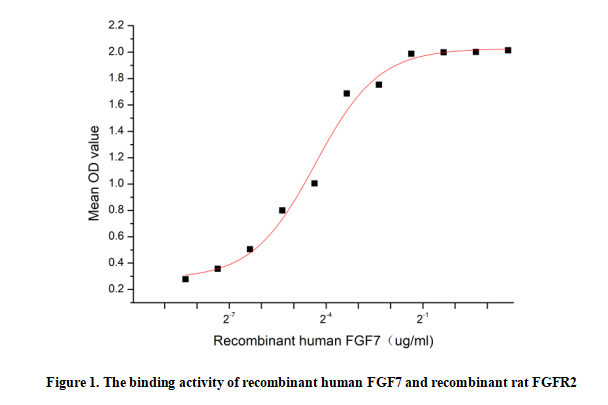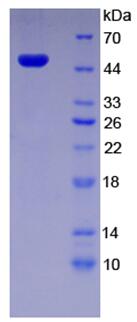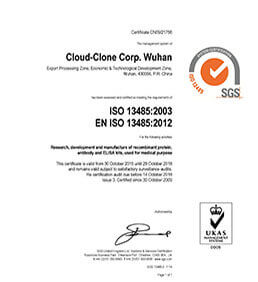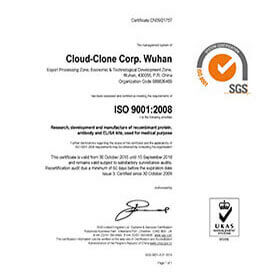Active Fibroblast Growth Factor 7 (FGF7)
KGF; HBGF7; Keratinocyte Growth Factor; Heparin-binding growth factor 7
- Product No.APA636Hu01
- Organism SpeciesHomo sapiens (Human) Same name, Different species.
- Buffer FormulationPBS, pH7.4, containing 0.01% SKL, 5% Trehalose.
- Traits Freeze-dried powder
- Purity> 95%
- Isoelectric Point9.5
- ApplicationsCell culture; Activity Assays.
- DownloadInstruction Manual
- UOM 10µg50µg 200µg 1mg 5mg
- FOB
US$ 360
US$ 900
US$ 1800
US$ 5400
US$ 13500
For more details, please contact local distributors!
ACTIVITY TEST

Fibroblast Growth Factor 7 (FGF7), also known as keratinocyte growth factor (KGF), is a paracrine signaling protein. It is mainly secreted by mesenchymal cells and specifically acts on epithelial cells. FGF7 plays crucial roles in cell proliferation, migration, and differentiation during development, tissue repair, and regeneration.FGF7 binds to Fibroblast Growth Factor Receptor 2 (FGFR2), particularly the IIIb isoform. This binding initiates a series of signaling cascades that regulate cellular functions essential for tissue homeostasis.Thus a functional ELISA assay was conducted to detect the interaction of recombinant human FGF7 and recombinant rat FGFR2. Briefly, FGF7 was diluted serially in PBS with 0.01% BSA (pH 7.4). Duplicate samples of 100 μl were then transferred to FGFR2-coated microtiter wells and incubated for 1h at 37℃. Wells were washed with PBST and incubated for 1h with anti-FGF7 pAb, then aspirated and washed 3 times. After incubation with HRP labelled secondary antibody for 1h at 37℃, wells were aspirated and washed 5 times. With the addition of substrate solution, wells were incubated 15-25 minutes at 37℃. Finally, add 50 µL stop solution to the wells and read at 450/630nm immediately. The binding activity of recombinant human FGF7 and recombinant rat FGFR2 was shown in Figure 1, the EC50 for this effect is 0.050ug/mL.
USAGE
Reconstitute in 10mM PBS (pH7.4) to a concentration of 0.1-1.0 mg/mL. Do not vortex.
STORAGE
Avoid repeated freeze/thaw cycles. Store at 2-8°C for one month. Aliquot and store at -80°C for 12 months.
STABILITY
The thermal stability is described by the loss rate. The loss rate was determined by accelerated thermal degradation test, that is, incubate the protein at 37°C for 48h, and no obvious degradation and precipitation were observed. The loss rate is less than 5% within the expiration date under appropriate storage condition.
GIVEAWAYS
INCREMENT SERVICES
-
 BCA Protein Quantification Kit
BCA Protein Quantification Kit
-
 Molecular Mass Marker for Protein
Molecular Mass Marker for Protein
-
 Monoclonal Antibody Customized Service
Monoclonal Antibody Customized Service
-
 Polyclonal Antibody Customized Service
Polyclonal Antibody Customized Service
-
 Protein Activity Test Experiment Service
Protein Activity Test Experiment Service
-
 Electrophoretic Mobility Shift Assay (EMSA) Experiment Service
Electrophoretic Mobility Shift Assay (EMSA) Experiment Service
-
 Buffer
Buffer
-
 Lentivirus Packaging Experiment Service
Lentivirus Packaging Experiment Service
-
 Adenovirus Packaging Experiment Service
Adenovirus Packaging Experiment Service
-
 Real Time PCR Experimental Service
Real Time PCR Experimental Service
-
 Spike RBD Protein (S-RBD)
Spike RBD Protein (S-RBD)
-
 Protein G
Protein G
-
 Protein A
Protein A
| Magazine | Citations |
| Journal of Controlled Release | A DPP-IV-resistant glucagon-like peptide-2 dimer with enhanced activity against radiation-induced intestinal injury pubmed:28522195 |
| Inflammation | Involvements of γδT Lymphocytes in Acute and Chronic Skin Wound Repair. pubmed:28540539 |
| Catalog No. | Related products for research use of Homo sapiens (Human) Organism species | Applications (RESEARCH USE ONLY!) |
| RPA636Hu01 | Recombinant Fibroblast Growth Factor 7 (FGF7) | Positive Control; Immunogen; SDS-PAGE; WB. |
| APA636Hu01 | Active Fibroblast Growth Factor 7 (FGF7) | Cell culture; Activity Assays. |
| RPA636Hu02 | Recombinant Fibroblast Growth Factor 7 (FGF7) | Positive Control; Immunogen; SDS-PAGE; WB. |
| PAA636Hu01 | Polyclonal Antibody to Fibroblast Growth Factor 7 (FGF7) | WB |
| MAA636Hu22 | Monoclonal Antibody to Fibroblast Growth Factor 7 (FGF7) | WB; IHC; ICC; IP. |
| SEA636Hu | ELISA Kit for Fibroblast Growth Factor 7 (FGF7) | Enzyme-linked immunosorbent assay for Antigen Detection. |
| LMA636Hu | Multiplex Assay Kit for Fibroblast Growth Factor 7 (FGF7) ,etc. by FLIA (Flow Luminescence Immunoassay) | FLIA Kit for Antigen Detection. |







